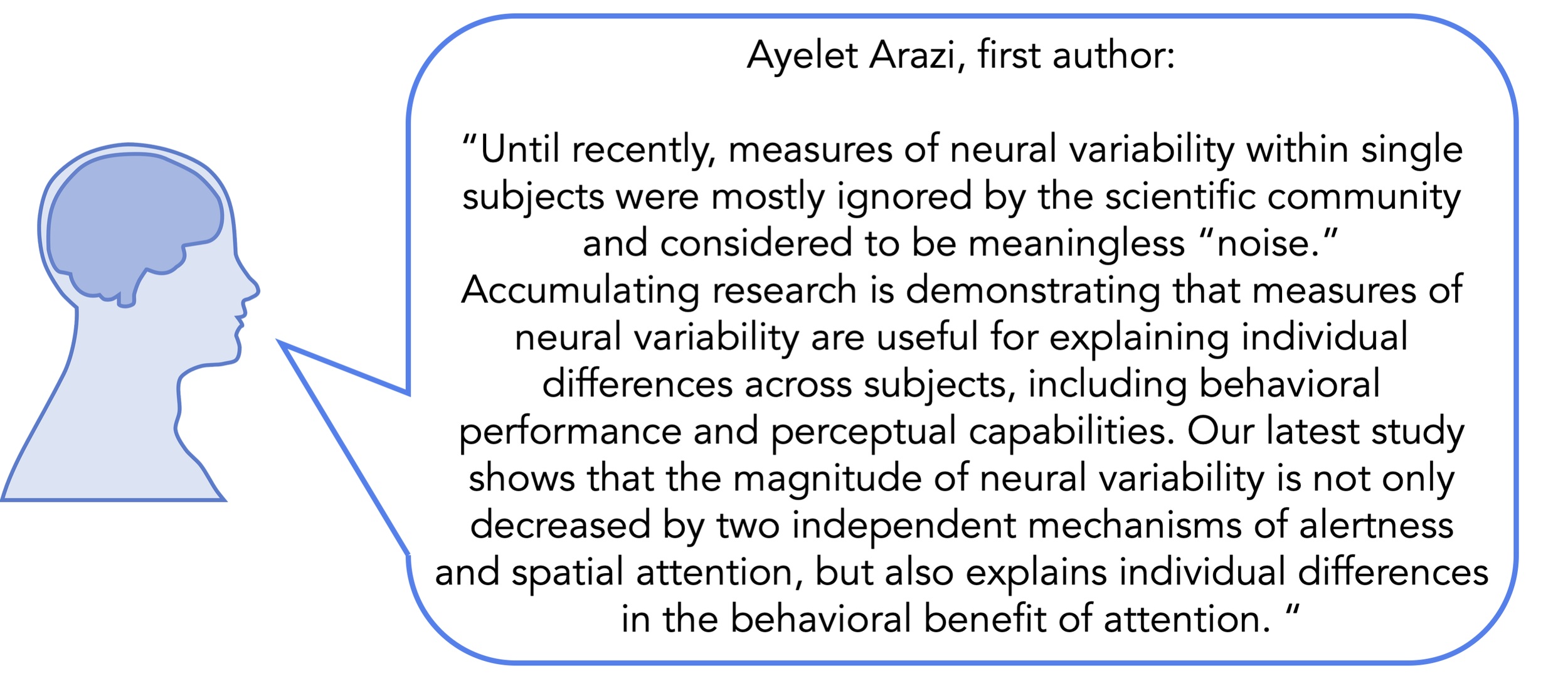Spatial Attention Quenches Neural Variability Within the Visual System
Post by Sarah Hill
What's the science?
Uncovering the underlying neural processes related to attention and alertness is currently an active area of research in neuroscience. Recordings of neural activity during tasks in which subjects were prompted to pay attention suggest that attention is marked by an increase in neuronal firing rate, as well as a decrease in firing rate variability, both within individual neurons and between pairs of neurons. In other words, attention appears to improve the neural signal-to-noise ratio by increasing and stabilizing neural activity. While many studies have modeled attention-related neural signal enhancement, much less is known about how attention reduces or 'quenches' variability in neural activity. This week in The Journal of Neuroscience, Arazi and colleagues report that neural variability within the visual system is selectively quenched by spatial attention.
How did they do it?
To study the effects of two different components of attention - alertness and spatial attention (or the focus of attention on a particular area of space) on neural activity, the authors used electroencephalography (EEG) to record and compare neural variability across two experiments. In the first experiment (termed the 'discrimination experiment'), human participants were briefly shown a cue (in this case, a white arrow on a computer screen) that was then followed by a target stimulus (a black and white striped circle appearing on the screen). In 60% of trials, the arrow pointed toward the location where the circle appeared shortly after, thereby directing participants' attention to a specific area of the computer screen. In the remaining 40% of trials the arrow pointed in either the opposite direction or in both directions. The subjects were then told to report which direction the circle's stripes tilted - left vs. right. In a second experiment (control), participants were presented with the arrow cue, but were not shown the circle stimulus (and were therefore not asked to report on the direction the circle's stripes). Consequently, participants in the control experiment were not prompted to pay attention to any particular location on the computer screen. In addition to having neural activity recorded through EEG, subjects' eye movements were tracked using electrooculography (EOG). The EEG and EOG recordings were then processed and used to compare neural variability between the two experiments.
What did they find?
First, for trials of the discrimination experiment in which the arrow cue correctly indicated the location of the circle stimulus, participants had higher rates of accuracy in reporting the direction the circle's stripes tilted towards. This suggests that participants were focusing their attention on a particular spatial area of the computer screen following presentation of the arrow cue. Next, the authors observed a significant reduction in neuronal firing variability following presentation of the arrow cue in both the discrimination and control experiments, though quenching of neural variability was greater in the discrimination task than in the control task. This result demonstrates that alerting the subjects to an upcoming stimulus reduces neural variability. To confirm this, they measured neural variability across intervals directly before and after cue presentation, finding that the magnitude of variability was significantly smaller in the discrimination experiment compared to the control experiment following cue presentation, but not before. Intriguingly, quenching of neural variability in the discrimination experiment appeared restricted to electrodes placed near the visual cortex, suggesting that spatial attention specifically modulates activity within the visual system. To further examine the effects of spatial attention, the authors noted the degree of variability quenching exhibited by each electrode when the cue pointed left vs. right in the discrimination task, observing that quenching was greater in electrodes placed contralaterally to the field of view being concentrated on. Finally, subjects with the largest reductions in neural variability following cue presentation also benefited the most from directed spatial attention, as indicated by comparing each subject's accuracy rates when the cue pointed in the correct direction versus when it pointed in the opposite direction.
What's the impact?
This is the first study to examine the effects of spatial attention on neural variability in humans. The authors showed that in addition to increasing neural activity, spatial attention and alertness minimize neural noise, thereby optimizing the neural signal-to-noise ratio specifically within the visual system. This study also provides compelling evidence that the benefits of attention may not be the same for all individuals, which is particularly relevant in terms of developing interventions for disorders such as ADD and ADHD.
Arazi et al. Neural variability is quenched by attention. The Journal of Neuroscience (2019). Access the original scientific publication here.


